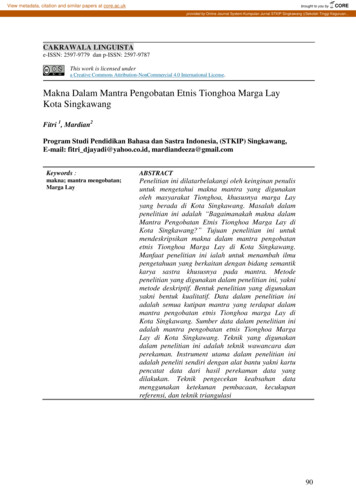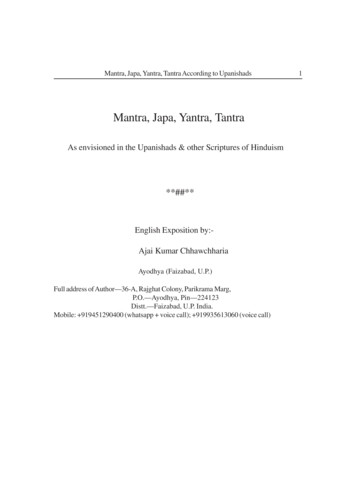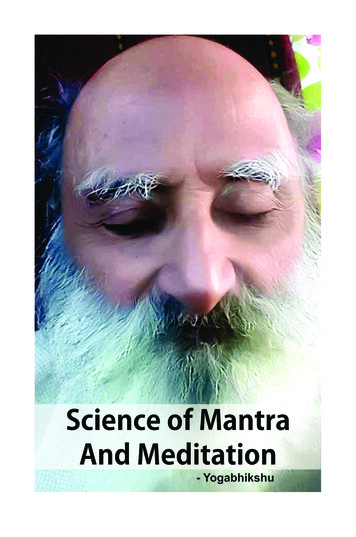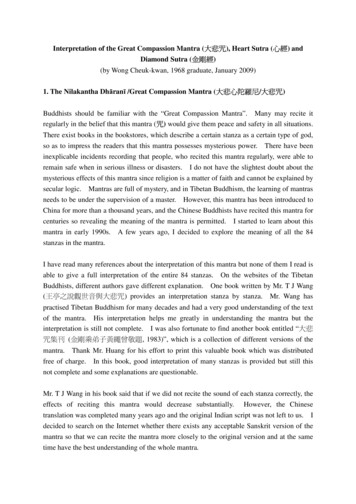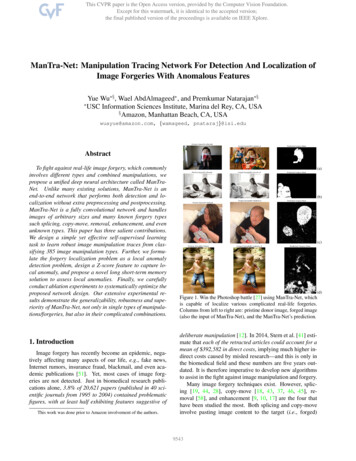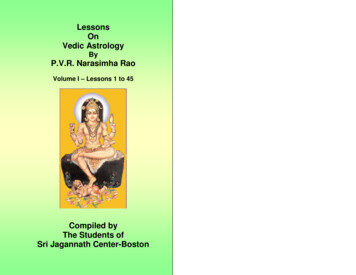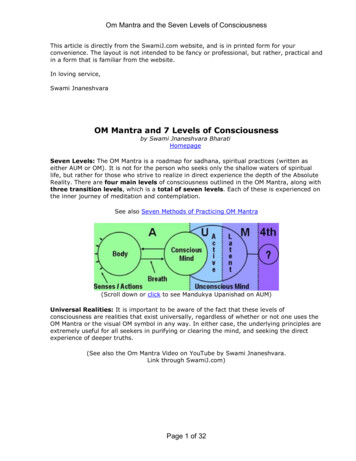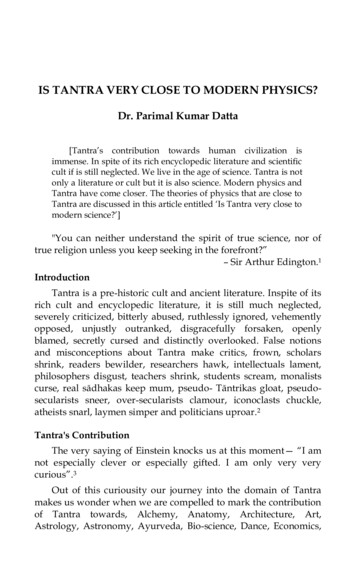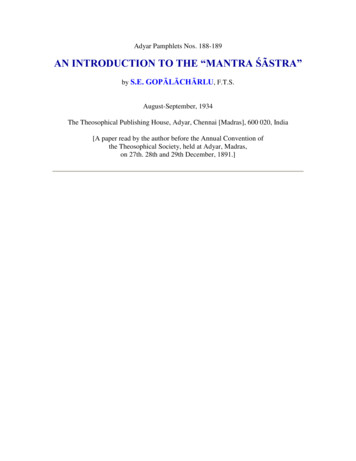
Transcription
Adyar Pamphlets Nos. 188-189AN INTRODUCTION TO THE “MANTRA ŚÃSTRA”by S.E. GOPĀLĀCHĀRLU, F.T.S.August-September, 1934The Theosophical Publishing House, Adyar, Chennai [Madras], 600 020, India[A paper read by the author before the Annual Convention ofthe Theosophical Society, held at Adyar, Madras,on 27th. 28th and 29th December, 1891.]
TABLE OF CONTENTSPREFACE . 3SECTION – I THE NATURE OF MANTRAS . 4SECTION II OCCULT CORRESPONDENCES . 12SECTION III PURAS'CARANA . 16SECTION IV THE NATURE AND TEACHINGS OF THE TANTRAS . 22
PREFACE[Page iii]MANTRA ŚĀSTRA is another department of Occult Science, which has for its objectsall kinds of Siddhis or acquirements of powers for securing the objects aimed at by meansof invoking the gods presiding them by repeating such Mantras or formulas as areintended for the purpose with the necessary ceremonies attending thereto. The whole ofthe four Vedas consist of nothing but Mantras, and as they proceed from the Pranava (theword Aum), the Pranava, consequently Ādi or Mūla Mantra or the Mantra of all Mantras;and it is acceptable to both the followers of Nigamas (the Vedas) and Agamas (theTantras). For this reason no Mantra can become effective or powerful without uttering thePranava in the commencement of it.For the acquirement of the successful study and practice of this S'astra, the purity ofbody, speech, and mind is the first condition attending it; otherwise, they would lead toBlack magic and to its disastrous results: that is to utter [Page iv] destruction of the soul orthe higher Manas. Strong will - power and undaunted courage are also the conditionsrequired for this purpose.Though the Mantra and Yoga S'astras belong to the occult science, yet the differencebetween them is very great. The former is an objective science and the latter is asubjective one.The Mantra S'astra develops the powers by appealing to the external objects, such as godsand goddesses (the forces in nature), while the Yogin develops them by self-culture or byunifying or identifying himself with the manifested universe as part and parcel of theIs'vara or the Creator.The Yogin by the virtue of his culture, gets all the powers of the Siddhis without effortwhile the Mantrika has to evoke them by the Mantras and the ceremonies attending them.In order to make this difference clear to the mind of our readers, we have in this formreprinted the paper read by Mr. Gopalacharlu and hope that our object will beaccomplished.We specially draw the attention of our readers to the fourth Section on “The Nature andTeachings of the Tantras”.T. P.H.
SECTION – I THE NATURE OF MANTRASIT is with great diffidence that I ascend the platform today, to give you my few thoughtson mantras, a subject which, however interesting it may be, cannot be exhausted in a fewessays. My object then is to place before you the results of my own studies in thatdirection, subject, of course, to the correction of my more advanced fellow Theosophists;and thus to benefit myself in one way.I can only give you, owing to the shortness of the time at my disposal, the barest outlines[Page 2] of the subject. It is impossible for a single individual to master the informationtreated of in 37,00,000 verses containing the original writings on mantras and Occultism,known as the Ãgamas, besides several other works now supposed to have been lost; foroccultism is treated in these writings in all its phases, and a theoretical knowledge ofthem presupposes a good deal of practical knowledge in one of them at least.I cannot too strongly impress upon your minds the necessity of my giving references, andin important points quoting the authorities in support of my arguments, more especiallybecause a slur has been cast upon us that we do not correctly represent the views of theancients, and that we give out as correct what emanates from our brains, without takingthe trouble of seeing whether our statements are borne out by the master-minds of old. I,for one, beg leave to admit for a moment, without quoting any instances of such neglectof duty, the truth of such statements, and believe that you will all agree with me that thecharge is partially true at least. I would therefore try my best to support my statements,with references to the best authoritative writings; for if we give the public, any moreroom to think [Page 3] of us as they now do, not only will the truth of our doctrines beless and less appreciated, but we shall be in their eyes no better than a set of self - styledmasters who have nothing to show for our title.The importance of sound has been most excellently sung by a poet of the Rig-Veda,hoary with antiquity and wisdom, when he said:Catvāri vāk parimitā padāni tāni vidur brāhmanā ye manīsinah, guhā trīni nihitānengayanti, turīyam vāco manusyā vadanti.This literally means: All vāks are of four kinds: so the Brāhmanas learned in the Vedas(know); three of which are latent, and the last is spoken.This statement gave rise to the fourfold classification. The Vedas have been divided intofour; the Vaidikas — l use the term in the sense in which Yāska used it, viz., the ancientVedic teachers — say that the Pranava (Om) and the three mantras known as Vyāhrtis(Bhūh, Bhuva; and Suvah) are here referred to; the grammarians consider the same
passage as referring to the grammatical forms and [Page 4] terminations, nāman, ākhyāta,upasarga and nipāta; those following the school of Nirukta interpret the same as the Rc,Yajus, Sāman, and the words spoken of in the world. Those versed in Mantras'astra onlyenlarge the views of the last named by explaining them to mean the Parā, Pas'yantī,Madhyamā and Vaikharī forms of Vāk. [This Mantra forms the 45th hymn of the 164thSūkta of the 22nd Anuvāka of the 1st Mandala of the Rg-veda. This Sūkta contains 52hymns the Rsi of which is Dīrghatamas. The first 41 Mantras are addressed toVis'vedevas; the 42nd and 45th to Vāgdevī, who is explained by Sāyanācārya to mean thesame as the Logos. I would in this connection refer the reader for further details to Yogas'ikhopanisad ]This last interpretation is the basis on which the mantras were formed as I shall show youlater on.The potency of sound has been spoken of in very high terms by all writers of antiquityand by none more so than Patanjali himself, the well-known author of the Yoga Sutras, inhis more splendid work, the Mahābhāsya, a commentary on the grammatical rules ofPānini. He says, the four horns [The reference is here to the Vedic passage: “Catnāris'rngā trayo asya pādā dvé s'īrse sapta hastāso asya, tridhā baddho vrsabho roravītimaho devo martyān āvives'a”are the four classes in [Page 5] which the Brahman is compared to a Bull; and this passagePatañjali takes for his authority. Kayyata in his commentary on Mahābhāsya says that thisis a description of Śabdabrahman (Logos) under the character of a Bull. The meaning ofthe Mantra is:Words, noun, verb, prefix, particle, and other kinds (of grammatical terminations). Thethree feet thereof are the three times, the past, the present and the future; the two headsare the two natures of sound, the eternal, and the factitious. The seven hands there are theseven case affixes. “Trebly bound”, i.e., connected with the three localities, the chest, thethroat and the head. The bull (vrsabha) is so called from its showering down (varsana) (i.e., showering down enjoyments). It bellows ( roravīti ), i.e., makes a sound. How is this? The verb means 'making a sound'. The ‘great God did enter mortals' : the great God,i.e., sound; mortals in men whose lot it is to die: these he did enter in order that theymight become assimilated with the God.This statement has been explained by his commentators to mean that the ETERNALSOUND has become manifested in man, in order that he may be again assimilated intoHim (The Eternal Sound or Śabdabrahman or the Logos) verily the man that knows thefitness of speech, whose sins have been removed by the employment of speech precededby a knowledge of language and who, having split the knots of egotism, doth enter. [Page6]
Patañjali next turns his attention to the Vedic hymn I have already quoted, and proceedsto say:Another text says: Four are the kinds of words, the divisions of speech. Hence do knowthe knowers of Brahman (Brāhmanāh) who have will over the mind; three placed in thecave, [ Vivarana explains ‘cave' to mean ‘where the occult development of sound takesplace'. By ‘not getting a glimpse thereof’ is meant 'their not being the depositories of anykind of knowledge in regard to the three stages of sound anterior to its articulation.'] mentake no notice of; the fourth (degree) of speech they utter'. The 'four words' that are thedivisions of speech are the four sets of words, the nouns, verbs, prefixes and particles.'Thou dost know the knowers of Brahman who have will over their minds,' – who havethe will of their minds,(or have the mind in subjection to the will) — such is the meaningof the word manīsin. 'Three placed within the cave', they take no notice of; — of the threeplaced within the cave 'they take no note', they busy themselves not with them, they getnot a glimpse thereof. 'The fourth (part) of speech men do utter' : the fourth (turīya) isthat fourth part (of entireness) of speech which is found among men.I have almost literally translated the words of Patañjali as a writer on grammar — thegrammar of factitious speech, the proper study of which, he says, preserves the Vedasand prevents their corruption saying. By saying ‘factitious speech’ he means the VaikharīVāk, for we believe that the other three forms of Vāk form the subject of occult sciences.[Page 7]The Hindus believe that Hanūmān was taught by Sūrya in nine grammars: and leaving offthe ninth which treats of the factitious language, we have the eight grammars speakingthe hidden forms of speech, the number eight including certain intermediate stages of thethree latent Vāks or forms of speech alluded to above. This lowest form of speech is theobject of knowledge, and one of the objects of which is obtaining the full knowledge ofwords, or, to adopt Patañjali's explanation, in order to obtain a command over his ownmind.“Of trinal speech distinguished by its several locations as the pronounced ( Vaikharī ), theintermediate (madhyamā) and the seeing ( pas'yantī ). This marvellous one is the ultimatedegree. Among these the pronounced is that which is the object of hearing, theintermediate abiding in the region of the heart is the cause of discourse, since (else) therewould never be words perceived; but the pas'yantī or 'the seeing' (so-named activelyhonoris causa; while it means, what is seen by the enlightened) is beyond vulgarconcernment, but in it moreover do those with concentrated minds arrive at thedistinction between the bases and the affixes. But in the ultimate (parā vāk), it is not so(no [Page 8] distinction of parts) being there discoverable. Speech is on that account saidto be ' trinal '. [ Bartrhari's Vākyapadīya quoted by Nages'abhatta in hisBhāsyapradīpoddyota. I may here add that Bhartrhari was one of the first commentatorson the Mahābhāsya; and the subsequent commentary of Kayyata, and the commentarythereon by Nages'abhatta, are based on this great work which is said to have consisted of100,000 granthas ]
It is plain from what has been said above that the laws which govern ordinary speech alsogovern mantras, the latter being only speech arranged according to certain modulations ofsound. Such being the case we shall now enquire into the signification of the word'mantra'.‘Mantra' has been derived from the root man to think: and it has among several otherways, also been explained to be so called on account of its protecting the Upāsaka, i.e.,one who develops the occult power by practising it with its accompaniments, from allsorts of dangers and difficulties. The word is also cognate with Manana meaning ‘tothink', and described as one of the paths leading to Brahman. Mantras are of the Vaikharīvāk and correspond to the Sthūla plane of matter.The origin of mantras and devātas is this. Brahman which is known in the Mantras’āstrasas Bindu, possesses a force called Bīja, but known in the Vedāntic Writings as S'akti or[Page 9] Prakrti. Their united action is Nāda, of S'abdabrahman or the Logos. There is,however, a little difference of opinion among this class of occultists as to the nature ofthe sounds uttered by the Mantras. One class thinks them to be manifestations of theLogos; others again consider them as the manifestations of the S'akti, and say thatS'abdabrahman is the consciousness in all things. This consciousness resides in man inthe Kundalinī Nādī and is said to be the origin of all the letters of the Alphabet.We have now three kinds of creations. From Bindu we have in order, Sadās'iva, Rudra,Visnu, Brahmā, which are either so many different Logoi, or different aspects of one andthe same principle. The other creation is from S'akti. Its first manifestation is Mahat,which is either Sāttvika, Rājasa or Tāmasa. These give rise to the three kinds ofAhamkāra. On the plane of Ahamkāra we have the ten deities known as Diks ordirections, Vāyu, As'vins, the Fire, the Sun, [ It must be here said that the sun, fire. etc.,do not mean those on the physical plane with which we are acquainted, but their astral, orin some cases, even higher counterparts ]. Pracetas, Indra, Upendra, Mitra, and the tensenses and the Tanmātras. From these last we have the five elements [Page 10] known toIndian philosophy. Each one of them is thus symbolised.All the letters of the Samskrt Alphabet belonging to these tattvas follow the symbol usedfor the particular class to which they belong and these symbols play a not unimportantpart in the practice of the Mantras.From these elements the physical body of man takes its origin, and in it the Kundalinīforce is located. The three nādīs known as Idā, Piʼngalā and Susumnā extend from thenose to a little below the navel, and the Kundalinī is located a little above the anus. It isdescribed as coiled like a serpent, and when awakened by the power of Yoga, it becomes
straightened, and shuts the passages to the three nādīs mentioned above. According toIndian writers, S'abda takes its origin in the Kundalinī; and it is the sound which takes itsrise from Kundalinī that passes the three stages Parā, Pas’yantī and Madhyamā and at lastcomes out as the one which we all hear and speak comprising the fifty letters of theSamskrt [Page 11] Alphabet. It has been briefly said that the world of S'abda takes itsorigin from sounds. In other words, it means that a name or sound expressed to denote aparticular object is identical with the object itself. This idea will no doubt appear very curious to those of us who have been used to themodern way of thinking, but is pre-eminently an Indian idea; and no Indian writer hasexplained this theory more clearly than Patañjali, whom I quote once more:Among those (viz., sounds, or words, secular and spiritual) the secular in the first placeare such as cow, house, man and Brahmā. The scriptural are verily indeed as Agnimīlepurohitam (and such other passages found in the Vedas); now (let us take) ‘cow'. Here,which is the word ? That which is in the shape of a thing with dewlap, tail, hump, hoofs,horns — pray is that the word ? Nay, replies he (referring to Pãpini whose Sütras onSamskrt grammar and philology Patanjali comments upon). That is not a word, but verilya substance. Then — the hints, gestures and winking — is that the word? Nay, he replies— that verily is the action. Then the white, the black, the tawny, the spotted, is that theword? Nay, he replies, that verily is quality .Then that which in many is different (andyet) not different — and that which is not destroyed in things that are destroyed bydisintegration — that which in the common nature (of all that exists) — is that the word?Nay, he replies — verily is the form (implying the genus or Platonic idea). What then isthe word ? A word is that through which, when uttered, there is the [Page 12] cognition(i.e.,) things with dewlap, tail, hump, hoofs and horns, or in the world a noise; a noisewith a recognized series is a word or sound.This last statement has been explained by Kayyata to mean that an identity ( tādātmya)exists between a word and the object it signifies. It is generally said that the Kundalinīhas fifty letters. This means a great many things. It has been explained in theMantras'āstras that all the fifty letters take their rise in their parā form of course, from theKundalinī; and that the force latent in it becomes manifested in the forms of soundswhich to the ancient Indian grammarians comprised the fifty letters of the SamskrtAlphabet. When first any attempt is made to utter any sound, the sound of Pranava or Omis heard in the heart. It is in fact the very first sound that one is said to hear when heattempts to speak out any word: and in the case of any single sound (Ekāksara) as forinstance, the very first sound you would make, or one hears, before you pronounce theletter or sound, is the Pranava: and you hear this sound so long as one has life or Prāna.Of course we cannot ordinarily hear the sound of Pranava unless we are trained in Yoga.Proceeding from this analogy, they inferred, [Page 13] or knew that this sound can beheard everywhere, for, as I said before, any sound that is intended to be produced isalways preceded by the sound of Pranava.We thus see the reason why the ancients said that Pranava was the first of all sounds, andtherefore of all mantras; how it was held to be universal, and how on this physical plane it
came to mean Prāna. It also means Brahman, being co-existent with it in being universal:and being thus the first of all sounds every sound or mantra was considered itsmanifestation.We shall now proceed to consider the original of mantras. I have already said that soundcomes from the Kundalinī , through the nādīs, and the mouth. Those nādīs are hollow andterminate a little below the navel, and through them the ten kinds of air known as Prāna;Apāna, Vyāna, Udāna, Samāna, Krkara, Devadatta, Dhanamjaya, Nāga and Kūrma, taketheir rise.The sound proceeds from Kundalinī to one of the nādīs, the particular nādī beingdetermined by the letter intended to be produced. Thus letters A () to Ah () passthrough Idā, Ka ( ) Ma ( ) through Pingalā and Ya ( ) to Ksa () throughSusumnā. The three nādīs are [Page 14] presided over respectively by the Moon, the Sunand Agni; in other words there exists an intimate, and to us inexplicable, relation betweenthese deities, and the nādīs, the former influencing the latter. It is on this account that thesounds coming from Idā are known in Samskrt grammar as Saumya (literally related toMoon) and those from Susumnā as Ūsman meaning hot or fiery. The saumyas are also socalled, because they do not require much effort in pronouncing them as they pass straightthrough the Idā nādī. The letters Ka to Ma have sprung up from them. Thus, letters Ka toMa are called Prānins (animated beings) while A to Ah are called Prāna (life-principle).They are symbols of the twenty-five tattvas, the last letter Ma symbolising the twentyfifth principle the Jīvātman, or Paramātman according to the view we take. The thirdseries extending from Ya to Ksa, and coming through the Susumnā are called Vayāpakas,from their being extended, or composed of the other two series already spoken of, andthey play a very important part in the composition of mantras, for their insertion isentirely dependent on the result we may wish to obtain.To summarize then, the sound in its passage from the Kundalinī to the end of the nādīs[Page 15] is the stage of parā: that of its passage through the nādīs is its pas'yantī stage:from the end of the nādīs to the throat it is in its madhyamā stage, while that which passesfrom the throat to the mouth is its vaikharī stage. The sounds or letters on the physicalplane are divided into those of Prthvī, Ap, Tejas, Vāyu and Ākās'a.Thus:Vayu,— ka, kha, ga, gha, na, a, ā, r, ha, s'a, ya.Agni, — ca, cha, ja, jha, ña, i, ī, rī, ksa, ra.Prthvī, — ta, tha, da, dha, na, u, ū, l, sa, va, la.Ap, — ta, tha, da, dha, na, è, ai, Iī, sa.Ākās'a, — pa, pha, ba, bha, ma, ô, au, am, ah.Mantras being a combination of sounds to suit a purpose, they may be either of onesyllable or a thousand syllables. The latter being its maximum limit, mantras of one, two,and three syllables are, strictly speaking, arrangement of sounds scientifically blended
together to produce a result, and are consequently very potent: these and the foursyllabled mantras do not generally admit of any analysis whatever, as in the case of thoseof five syllables and more, for the reason that they are generally composed of the leastnumber of Bījas, and have no room for the insertion [Page 16] of the name of the devatāas in the case of the many-worded ones: and the only way we can find out the devatā isby a careful examination of the Bījas employed. Those of five syllables or more, aredivisible into (1) the Pranava, (2) the Bīja showing the object of the mantra, and (3) thename of the deity. Not all the mantras begin with Pranava, but those that begin with it areconsidered more sacred to a deity than those which do not begin with it. The reason isplain enough, being that the mere presence of Pranava, which is considered as the motherof all mantras, will accelerate the force of that mantra.The objects of the Mantras are various (1) Subjection (vas'ya), (2) attraction (ākarsana),(3) fascination (mohana), (4) deadening the faculties (stambhana), (5) creating enmity(vidvesana), (6) death (mārana), (7) ruining ( uccātana), (8) soothing ( āpyāyana) ; andthe Bījaic terminations show the object of Mantras. In case of vas'ya, uccātana, andākarsana, the termination hum should be used; phat for mārana; namah for stambhana,vidvesana and mohana; vausat for āpyāyana. This rule should be observed by a beginner,but when once he masters a mantra, this act being known as Mantra-siddhi, he masterswill-power [Page 17] also, and can then use any termination for fulfilling any object. Butimmediate results will follow if he also pays attention to the above rule. This leads us tothink that only the efficacy of the will-power is necessary, but there is a sort of efficacy inthe sounds themselves uttered during the repetition of a mantra.Mantras are either masculine, feminine, or neuter, according to the nature of the devatāaddressed to, and of actions. Those addressed to a female deity , are also called vidyās.The eight purposes above mentioned may be thus classified according to the nature of thedevatā addressed. Those that terminate with the endings hum and phat are male mantras;but there is a class of Indian Occultists who consider every mantra as masculine. Thoseending with svāhā and vausat are feminine in their action, while those with namah areneuter. Probably the reason for this classification lies in the fact that the pronunciation ofhum and phat are more forcible, and produce a greater disturbance in the ākās'a, thaneither svāhā, vausat or namah. Under the head of feminine mantras again are included allsuch mantras of one syllable, but consisting of more than one letter as kma, khma, kra,etc. [Page 18]One of the advantages of this classification is that these mantras may be best practised bypersons enjoying different periods of life; for it is laid down almost as a rule that thefeminine mantras should be practised before sixteen years of age, and the rest above thatage.The excellence of the Samskrt alphabet will be apparent when we consider that one hadall the occult laws above hinted at, can be observed only in connection with it, and noneelse; and also that the knowledge of occult dynamics which the ancients possessed,enabled them to find out that these laws can be best worked out in the case of this
Alphabet called Samskrt, meaning 'well-done' or 'well-arranged'; in short a perfectAlphabet.The number of mantras existing in the Samskrt language is generally stated in occultwritings as seven crores. This gives us only a rough idea, but the exact number is67,108,863. Every mantra of any number of syllables must fall under one of the 26 kindsof Chandas, and that the number given out in works on Samskrt prosody. These denotethe 26 ways in which different sounds can be arranged, taken one at a time, two at a time,and so on, the total number of ways in which they can be so arranged being, as we [Page19] know from algebra, 2 26; — 1 or 67,108,863. Mantras are also divided into those ofAgni and Soma. If in a mantra there are more letters coming out from Pingalā Nādī it isAgni mantra; if of Susumna, it belongs to Soma and is called a Saumya mantra; and soon. [Page 20]
SECTION II OCCULT CORRESPONDENCESONE of the most secret correspondences existing between the mantras on the VaikharīVāk or the Sthūla plane of matter, and the higher planes is Bījas , which I have partlyhinted at in the preceding Section. The central idea involved in the working of themantras is that certain sounds when uttered produce a disturbance in the Ākās'a which is,in its turn communicated, according to the severity of such a disturbance, to the higherplanes. It stands to reason, therefore, that the greater the disturbance, the greater will bethe communication to the higher planes. The nature of the disturbance cannot be judgedfrom the known laws of physics, as that science has rarely meddled with the higherplanes of matter. All that we can, therefore, say is that there exists some relation betweensounds, and the disturbance in the Ākās'a , and that certain kinds of sounds producecertain kinds of disturbance. These sounds are known in Samskrt [Page 21] by the name ofBījaksaras, and they have been classed under various heads, denoting those the effects ofwhich are of a particular nature; the latent forces in the letters being known as Bījas. Allthe letters of the Samskrt Alphabet are also Bījaksaras, and as everything in nature can bejudged from the three standpoints of Visnu, S'iva and S'akti, we have also three differentsets of meanings according as they are either Vaisnava, S'aiva and S'akta. Thus there arethree ways of interpreting a mantra, composed as it is of various Bījaksaras, andaccording as it belongs to either Visnu, S'iva or S'akti. It must at the same time be saidthat each one of these devatās, is an aggregate of several forces, each known in its turn bythe name of devatā; and one can easily see by inspection, what particular force isintended to be invoked in a given mantra. These ideas should be borne in mind for acorrect understanding of what follows.A chart is given at the end, as an appendix, containing the significations of the Bīja forceslatent in the 50 letters of the Samskrt Alphabet; as such a thing will be too tedious if itfinds a place in the body of the essay. It has been prepared at the expense of, a good dealof labour, as it involved the study of [Page 22] more than seven or eight large Samhitās; inthe three sets of Āgamas, — Pāñcarātra, S'aiva and S'akta. A very curious conventionalityis found to have been used in the Āgamas, viz., of designating Bījaksaras, by the names ofcertain trees; as for example, “Join Mandāra with Visnu”. Here “Mandāra” would beordinarily understood to mean the Mandāra tree but such an explanation will be found notto have been borne by the context. It means that the Bījaksaras called “ra” should beadded to Visnu Bījaksaras ' a', and should be pronounced “ara”. This is given here as anillustration to show how the mere wording of the text of Mantras'āstras is apt to bemisunderstood, and why such a thing as initiation into them is necessary. Such sorts ofexamples have collected and explained as far as the materials could be obtained, and willalso be found in the appendix. This sort of finding out the mantras is calledMantroddhāra. Among the uses of Bījaksaras, may be mentioned the placing of certainBījaksaras in the beginning of the verses composed. A poet, for instance, and in this casehe must be a good adept, wishing to destroy a house or anything belonging to anotherperson, sings a song beginning with one of the Agni or fire Bījaksaras and [Page 23]which means that the house should be burnt. Cases of this sort have occurred, but they all
depend on the occult powers conquered by the composer. Kālidāsa and several others aresaid to have done so. Similarly good may be done to anyone. But as the tendency in thosewho are not Brahmajñānins, is to do more harm than good, such things should bediscountenanced as far as possible.It must, therefore, be understood that all the mantras which may mean nothing else thanthe effect required, are not devoid of force whatever. A magician, for instance, wishing topurify the magnetic aura of a chair would merely say “Ram agnaye namah” fancying orwilling himself during the repetition, that fire purifies the chair, and if he is sensitive, hewould feel that the aura surrounding it has been purified.As regards the question of relation of mantra, to the force it symbolises, no clear wordscan be found in the Mantras'āstras. Such explanations as when literally translated mean“the devatā is of two forms, viz., that of a mantra, and that of the Sūksma S'arīra”, occur,but they do not in any way enlighten us. There seems to be a good deal of mystery cast onthis question by the Agamas, but judging from their [Page 24] context in the Mantras'āstrasand from S'amkarācarya 's words in his famous Commentaries on the Brahma Sūtras (1.3. 33) that a devatā has the power of a
AN INTRODUCTION TO THE "MANTRA ŚÃSTRA" by . S.E. GOPĀLĀCHĀRLU, F.T.S. August-September, 1934 The Theosophical Publishing House, Adyar, Chennai [Madras], 600 020, India [A paper read by the author before the Annual Convention of the Theosophical Society, held at Adyar, Madras, on 27th. 28th and 29th December, 1891.]


